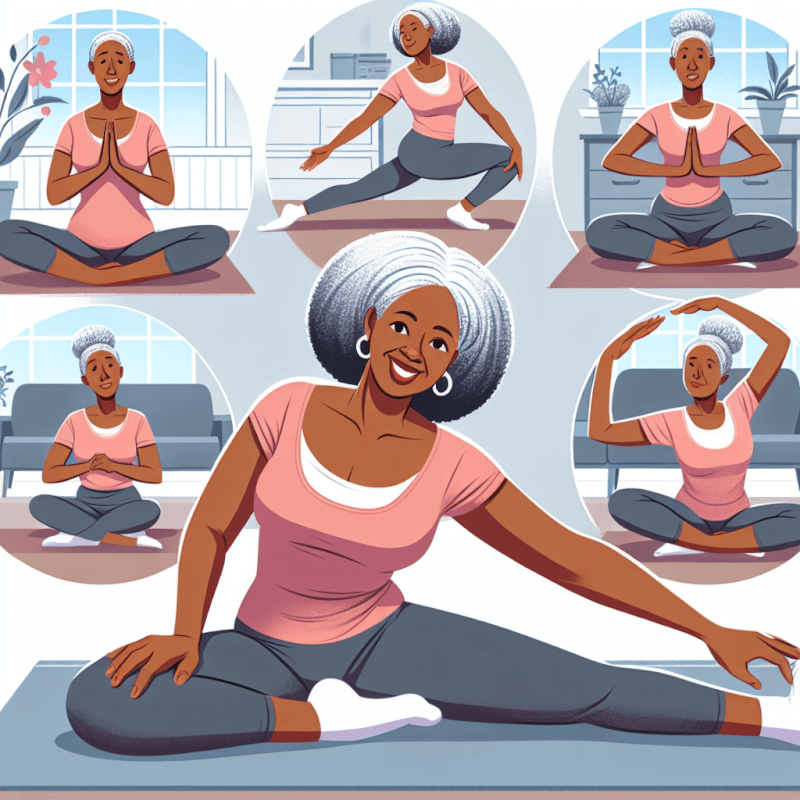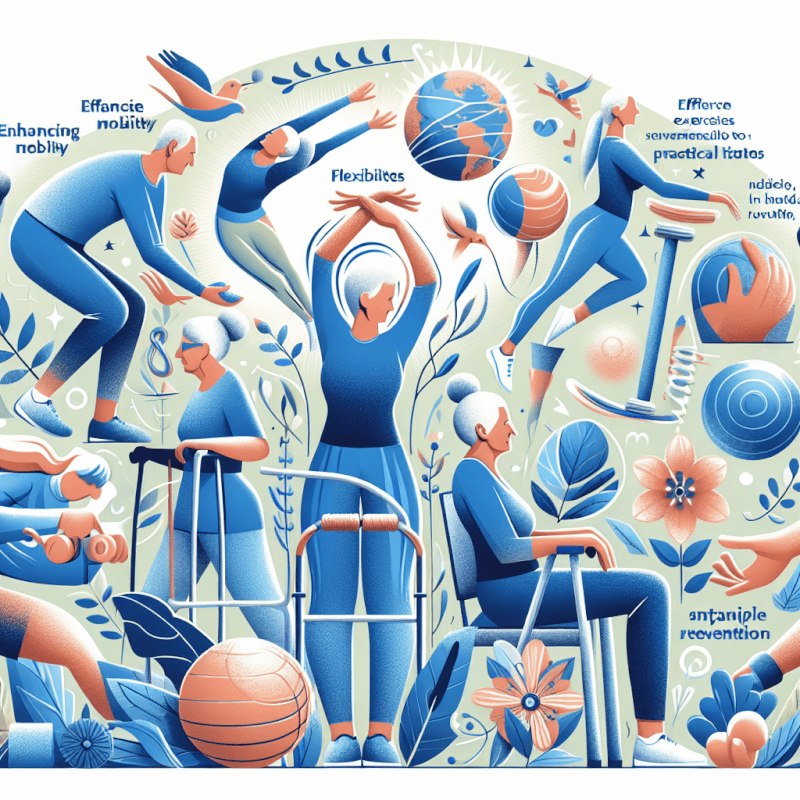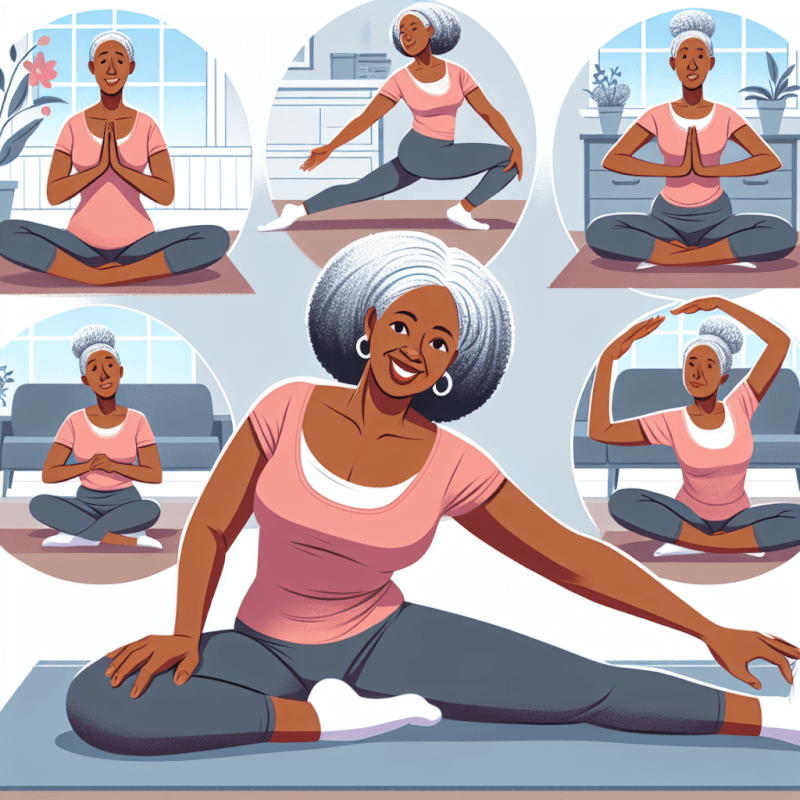As you traverse into your golden years, maintaining flexibility becomes increasingly crucial. It not only enhances your quality of life, but also helps prevent injuries and aids in performing daily activities with ease. So, what are the best ways to increase flexibility after reaching the milestone of 50? In this article, we will explore some effective and enjoyable methods that will help you stay limber and agile well into your later years. Get ready to embrace a more flexible you!
1. Stretching exercises
As you age, your flexibility may naturally decrease, making it important to incorporate stretching exercises into your routine. Stretching helps to improve joint mobility, increase blood flow to the muscles, and prevent injury. There are various types of stretching exercises that can be beneficial for increasing flexibility after 50.
1.1 Yoga
Yoga is an excellent form of exercise that focuses on flexibility, strength, and balance. It involves holding poses and flowing through a series of movements while paying attention to your breath. Yoga not only helps to stretch and lengthen muscles but also promotes relaxation and reduces stress. It is a low-impact exercise, making it suitable for individuals of all fitness levels, including those over 50.
1.2 Pilates
Pilates is another great option for increasing flexibility. It focuses on strengthening the core, improving posture, and enhancing flexibility. Pilates exercises often involve controlled movements and specific breathing techniques. This form of exercise can help to lengthen muscles, improve joint range of motion, and enhance overall body awareness.
1.3 Static stretching
Static stretching involves holding a stretch for a prolonged period, typically between 15 to 60 seconds. This type of stretching helps to improve flexibility by increasing the length of muscles and tendons. It is important to perform static stretches after your workout or when your muscles are warm. Some examples of static stretches include hamstring stretches, quadriceps stretches, and shoulder stretches.
2. Strength training
Strength training is not only beneficial for building muscle and increasing strength, but it can also contribute to improving flexibility, especially when done properly.
2.1 Resistance exercises
Resistance exercises, such as using resistance bands or weights, can help to strengthen the muscles and increase flexibility. By gradually increasing the resistance over time, you can challenge your muscles and improve their flexibility. It is important to focus on proper form and technique to avoid injury and maximize the benefits of resistance exercises.
2.2 Bodyweight exercises
Bodyweight exercises are an effective way to build strength and improve flexibility without the need for equipment. Exercises such as squats, lunges, and push-ups can help to increase joint range of motion and enhance overall flexibility. These exercises can be modified to suit your fitness level and can be performed at home or in a fitness facility.
2.3 Weightlifting
Weightlifting, when done with proper form and technique, can also contribute to improving flexibility. By performing exercises that target multiple muscle groups, such as deadlifts and overhead presses, you can enhance joint mobility and increase overall flexibility. It is important to start with lighter weights and gradually increase the load as your strength and flexibility improve.

3. Balance and stability exercises
Maintaining good balance and stability becomes increasingly important as you age. These exercises not only help to prevent falls but also contribute to overall flexibility and mobility.
3.1 Tai Chi
Tai Chi is a Chinese martial art that involves slow, controlled movements and deep breathing. It promotes balance, flexibility, and relaxation. The flowing movements in Tai Chi help to improve joint range of motion and enhance body awareness. Tai Chi is suitable for individuals of all fitness levels and can be practiced either in a class or at home.
3.2 Balance boards
Using balance boards can be an effective way to improve balance and stability. These boards challenge your core muscles and force you to engage your stabilizing muscles. By regularly incorporating balance board exercises into your routine, you can enhance your proprioception and increase your overall flexibility.
3.3 Yoga for balance
In addition to its flexibility benefits, yoga can also help to improve balance and stability. Certain yoga poses focus on challenging your balance, such as tree pose or standing on one leg. By practicing these poses regularly, you can strengthen your core and lower body muscles, leading to improved balance and stability.
4. Foam rolling
Foam rolling, also known as self-myofascial release, is a technique that involves using a foam roller to apply pressure to specific areas of the body. This practice helps to release tension, increase blood flow, and improve flexibility.
4.1 Techniques for foam rolling
To foam roll effectively, start by placing the foam roller on the targeted muscle group. Apply gentle pressure and slowly roll back and forth, focusing on any areas of tightness or discomfort. Spend more time on these areas to release tension and promote flexibility.
4.2 Benefits of foam rolling
Foam rolling can provide various benefits for increasing flexibility, especially after 50. It helps to break up scar tissue and adhesions, which can restrict mobility. Additionally, foam rolling can improve circulation, reduce muscle soreness, and enhance overall range of motion. It is a simple and affordable tool that can be easily incorporated into your daily routine.

5. Massage therapy
Massage therapy is another effective way to increase flexibility, reduce muscle tension, and improve overall well-being. Different types of massage techniques can be beneficial for individuals over 50.
5.1 Deep tissue massage
Deep tissue massage involves applying intense pressure to release chronic muscle tension and knots. This type of massage targets the deeper layers of muscle and connective tissue, helping to improve flexibility, reduce pain, and increase range of motion.
5.2 Thai massage
Thai massage combines stretching, acupressure, and deep massage techniques. It focuses on improving flexibility, releasing muscle tension, and promoting relaxation. The therapist uses their hands, elbows, knees, and feet to apply pressure and guide you through various stretches.
5.3 Myofascial release
Myofascial release involves applying gentle sustained pressure to the myofascial connective tissue to release restrictions and restore range of motion. It helps to eliminate pain, improve posture, and enhance flexibility. This technique can be performed by a massage therapist or by using specialized tools like foam rollers or massage balls.
6. Using props and aids
Incorporating props and aids into your flexibility routine can provide additional support and help you gradually improve your flexibility.
6.1 Resistance bands
Resistance bands are versatile tools that can be used to assist or challenge your flexibility exercises. They provide resistance and support, helping you to deepen your stretches and gradually improve your flexibility over time. Resistance bands come in different strengths, allowing you to choose the level of resistance that is appropriate for your current fitness level.
6.2 Stretching straps
Stretching straps are long, adjustable straps that can be used to assist with stretching exercises. They help to improve flexibility by allowing you to reach a deeper stretch while maintaining proper alignment. Stretching straps can be used for various stretches, such as hamstring stretches, shoulder stretches, and quadriceps stretches.
6.3 Yoga blocks
Yoga blocks are props commonly used in yoga practice to provide support and stability. They can be used to modify poses and help you maintain proper alignment. Yoga blocks are especially beneficial for individuals with limited flexibility, as they allow you to achieve the benefits of a pose without straining your muscles or joints.

7. Warm-up and cool-down exercises
Before and after your flexibility routine, it is important to incorporate warm-up and cool-down exercises to prepare your body for stretching and prevent injury.
7.1 Dynamic warm-up exercises
Dynamic warm-up exercises involve moving your joints and muscles through a full range of motion. These exercises help to increase blood flow, warm up your muscles, and prepare them for the stretching movements to come. Examples of dynamic warm-up exercises include jogging in place, arm circles, and lunges with a twist.
7.2 Joint mobilization exercises
Joint mobilization exercises focus on gently moving your joints through various ranges of motion. These exercises help to lubricate the joints, increase mobility, and reduce stiffness. Examples of joint mobilization exercises include wrist circles, ankle circles, and neck rotations.
7.3 Cool-down stretches
After your flexibility routine, it is important to include cool-down stretches to gently return your body to a resting state. Cool-down stretches help to relax and lengthen the muscles, prevent muscle soreness, and improve recovery. Performing static stretches, such as calf stretches and chest stretches, can be beneficial during the cool-down phase.
8. Incorporating flexibility into daily activities
Increasing flexibility doesn’t have to be limited to your exercise routine. There are various ways to incorporate stretching and flexibility into your daily activities.
8.1 Stretch breaks at work
If you have a sedentary job, it is important to take regular stretch breaks throughout the day. Set a timer or use an app to remind yourself to get up and stretch every hour. Simple stretches like neck rotations, wrist stretches, and standing forward bends can help to counteract the effects of sitting for long periods and improve flexibility.
8.2 Stretching while watching TV
Make use of commercial breaks or slow-paced TV shows to incorporate stretching into your leisure time. Perform stretches like seated forward bends, butterfly stretches, and seated twists while watching TV. This can be a relaxing way to unwind and improve flexibility without taking up additional time in your day.
8.3 Stretching during household chores
Turn daily household chores into an opportunity to work on your flexibility. While washing dishes, folding laundry, or vacuuming, take breaks to perform standing stretches like calf stretches, quadriceps stretches, and standing hip stretches. This not only helps to increase flexibility but also makes these seemingly mundane tasks more enjoyable.

9. Mind-body practices
Mind-body practices can be beneficial for both flexibility and overall well-being. These practices help you connect with your body, calm your mind, and enhance your overall flexibility.
9.1 Meditation
Meditation involves focusing your attention and eliminating the stream of thoughts that may be running through your mind. By practicing meditation regularly, you can improve body awareness, promote relaxation, and reduce stress. A calm and relaxed mind can positively impact physical flexibility and overall health.
9.2 Breathing exercises
Deep breathing exercises help to bring oxygen into your body, relax your muscles, and reduce tension. By focusing on your breath and practicing breathing exercises regularly, you can improve lung capacity, enhance relaxation, and increase overall flexibility. Incorporate deep breathing exercises into your stretching routine or practice them separately throughout the day.
9.3 Mindful movement
Mindful movement involves paying full attention to the present moment as you move your body. Whether you are practicing yoga, going for a walk, or performing any other exercise, focus on the sensations in your body, your breath, and the movement itself. By practicing mindful movement, you can enhance body awareness, improve flexibility, and deepen your mind-body connection.
10. Seeking professional guidance
If you are unsure about how to safely and effectively increase your flexibility after 50, consider seeking professional guidance from a physical therapist, personal trainer, or joining a flexibility-focused class.
10.1 Consulting a physical therapist
A physical therapist can assess your current flexibility, identify areas of weakness or tightness, and create a personalized stretching and exercise program for you. They can provide expert guidance and ensure that you are addressing your specific needs and limitations safely and effectively.
10.2 Hiring a personal trainer
A personal trainer with expertise in flexibility training can help you develop a well-rounded exercise program that focuses on improving your flexibility. They can provide instruction, offer modifications, and monitor your progress to ensure that you are performing exercises correctly and safely.
10.3 Joining a flexibility-focused class
Joining a flexibility-focused class, such as a yoga or Pilates class, can provide a structured environment where you can learn and practice various stretching techniques under the guidance of a qualified instructor. These classes often offer modifications for different fitness levels, making them suitable for individuals over 50.
In conclusion, increasing flexibility after 50 is achievable through a combination of stretching exercises, strength training, balance and stability exercises, foam rolling, massage therapy, using props and aids, warm-up and cool-down exercises, incorporating flexibility into daily activities, practicing mind-body techniques, and seeking professional guidance when needed. By incorporating these practices into your routine and staying consistent, you can improve flexibility, enhance mobility, and promote overall well-being as you age.



